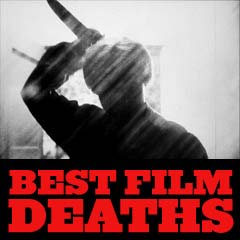
|
Deaths Scenes 1962-1963 |

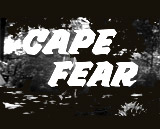
|
Cape Fear (1962) In the original version of this film, later remade by Martin Scorsese in 1991, Max Cady (Robert Mitchum) was wounded by gunshot from protective lawyer-husband Sam Bowden (Gregory Peck) after a fight to the death (and Sam's near-drowning) in Cape Fear River. After being overpowered and held at gunpoint, Cady taunted Sam to shoot him: "Go ahead. I just don't give a damn." But Sam decided not to kill him, in the last lines of the film:
|
   Face-Off Between Max and Sam |
||||||
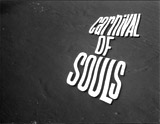
|
Carnival of Souls (1962) In this classic, low-budget horror film's final scene, it was revealed that all three female passengers in a car, including talented young organist Mary Henry (Candace Hilligoss), that plunged off a bridge and into a muddy river during a drag race, never survived the crash. However, in the film's opening, it appeared that Mary was the sole survivor of the accident when she emerged unscathed. Her dreams, imagined visions and trances involving the ghouls in a dance of death were due to her hallucinations during her death experience and entry into the spirit world. In the revelatory final scene, the submerged car (with Mary's corpse inside) was partially dredged out of the river. |
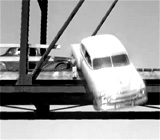 The Deadly Crash Off a Bridge 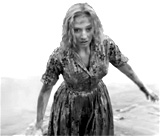 Mary's Imagined Survival 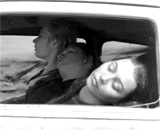 Corpses in Dredged-Out Car |
||||||

|
There was an exciting fight to the finish in mortal hand-to-hand combat over a reactor pool in the conclusion of this first James Bond action film. 007 James Bond (Sean Connery) managed to climb up to safety, but as head SPECTRE agent Dr. Julius No (Joseph Wiseman) desperately clutched at the steel supports of the descending platform, his metallic, artificial hands could not get a grip on the steel legs of the sinking gantry. He was submerged into the bubbling, scalding-hot radioactive water of the reactor, sinking into the steaming, boiling mixture where he met his death. |
  Sinking Into Reactor's Radioactive Water |
||||||
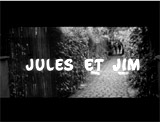
|
Jules and Jim (1962, Fr.) (aka Jules et Jim) Francois Truffaut's acclaimed New Wave romantic drama, based on Henri-Pierre Roché's semi-autobiographical novel, told of a doomed and unconventional love triangle from 1912 to the early 1930s. Over the course of two decades until the eve of World War II, the feminist in the tragic love triangle moved in and out of their affections:
Although there was love between all of them, Catherine married Jules and they lived in an Austrian chalet by the Rhine countryside. After the intervention of WWI, when the two men fought on opposite sides of the conflict, Jim reacquainted himself with Catherine and Jules, who now had a five year-old daughter named Sabine (Sabine Haudepin). However, their marriage was in disrepair, and Catherine was briefly romancing Jim. She seemed to need both men’s undivided attention. Jules even offered her a divorce if she'd marry Jim, so that they could all still be together, and he would share her vicariously. In the midst of the back-and-forth relationship between the three lovers, the vascillating and depressed Catherine decided to end things. She drove Jim across a broken and damaged bridge - the abrupt incident was ruled a murder/suicide by police. [Note: Some have suggested that the scene became the inspiration for the suicidal/murder drive into the Grand Canyon by Thelma & Louise (1991).] |
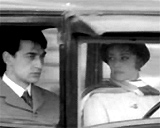  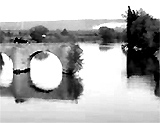 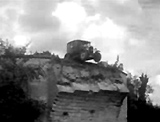
|
||||||
 |
In the film's opening prologue, multiple gunshots delivered by vengeful middle-aged literature professor Humbert Humbert (James Mason) wounded and killed Claire Quilty (Peter Sellers). Humbert was insanely motivated to commit murder for Quilty's duplicity - he emptied all six rounds of his gun into a portrait, killing Quilty through the painting. Quilty was blamed for his part in seducing, running off and abandoning nymphet teenager Dolores 'Lolita' Haze (Sue Lyon).
In the final epilogue scene (a continuation of the prologue), the ending shot was another view of the Victorian, Gainsborough-type watercolor painting. It depicted an 18th century genteel young woman - with a bullet hole torn through the face of the young girl - symbolic of the irrecoverably-marked life of Lolita. The epilogue's title card: "Humbert Humbert died of coronary thrombosis in prison awaiting trial for the murder of Claire Quilty." Lolita's mother Charlotte Haze (Shelley Winters) also met a timely death (off-screen) when hit by a car outside of her home, allowing widower Humbert to become Lolita's legal guardian and stepfather. |
 Prologue: "Do you want to die standing up or sitting down?" 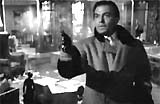 Humbert Humbert (James Mason) With Gun  Death Scene of Charlotte Haze |
||||||
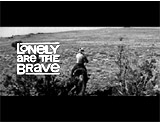
|
Lonely Are the Brave (1962) In this modern western film, itinerant free-spirited cowboy "Jack" Burns (Kirk Douglas) died during his flight for freedom (into Mexico) when pursued by lawmen led by Sheriff Morey Johnson (Walter Matthau), with helicopters and jeeps. In the end, Burns was struck by truck driver Hinton's (Carroll O'Connor) 18-wheeler tractor trailer (carrying toilets) whose vision was impaired by a torrential rainstorm. The truck plowed into Burns on his beloved horse Whiskey as they crossed busy Highway 66 and the animal balked.
When the Sheriff arrived, he told the state police that he couldn't identify Burns as the one he was looking for: "Man I'm looking for, I never saw him this close." Burns' eyes went wide when he heard a gunshot. He knew that his injured horse Whiskey had been put out of its misery (off-screen) - a mercy killing by Deputy Harry (William Schallert) - this symbolized the death of Burns as well. An ambulance pulled up and took Burns away, as the truck driver asked about his prognosis: "He ain't gonna die, is he?" - he was told: "How do I know?" In the conclusion, it was unclear whether Burns survived. The last image was of Burns' cowboy hat, drenched and in the middle of the highway. |
    |
||||||
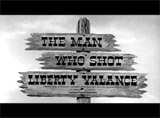
|
The Man Who Shot Liberty Valance (1962) A deadly western shootout occurred in the conclusion of John Ford's classic between two mismatched opponents:
Rancher/gunslinger Tom Doniphon (John Wayne) later revealed in a 'flashback within a flashback' ("You didn't kill Liberty Valance...Think back, Pilgrim") that he had actually killed the evil Valance. Doniphon had hidden on a side street and shot Liberty without anyone knowing at the moment of gunfire. He was intending to sacrificially protect the love of his life Hallie (Vera Miles) from heartbreak, knowing that without help, Stoddard would certainly have died in the face-off. Subsequently, Stoddard had received all the credit and notoriety for miraculously being "The Man Who Shot Liberty Valance." |
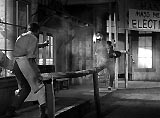 The Shoot-Out  Doniphon Seen From Another Angle  Death of Liberty Valance |
||||||
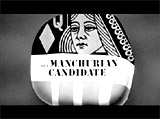
|
The Manchurian Candidate (1962) In the famous brainwashing/dream sequence set during the Korean War, Captain Bennett Marco (Frank Sinatra) and his platoon were present and onstage at a ladies' auxiliary meeting. The images switched between the imagined, delusionary, conditioned point of view within the brainwashed soldiers' heads and actual reality. They had been conditioned, programmed, and manipulated by a Pavlovian Chinese brainwasher to imagine attendance at a ladies' auxiliary meeting/tea party. Calmly, puppet-master Yen Lo (Khigh Dhiegh) demonstrated Sergeant Raymond Shaw's (Laurence Harvey) emotionless killing capacity through the technique of programming - of two fellow soldiers:
Later during a political convention, the 'programmed' killer Raymond (posing as a priest) also assassinated both his step-father Senator John Iselin (James Gregory) and his mother Mrs. Iselin (Angela Lansbury) on-stage.
Then he paused to don his own Congressional Medal of Honor around his neck (seen from behind) - a true hero who had finally lived up to his award. In the climactic finale, the crazed Sergeant Shaw (with the medal around his neck) turned the rifle on himself and suicidally blew his brains out (off-camera), in the presence of Captain Bennett Marco who had raced to stop him, but was too late. The echo of the gunshot blast dissolved into crackling lightning/thunder claps during a rainstorm. |
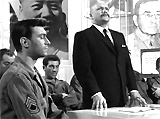  Raymond Shaw's Strangulation of Mavole   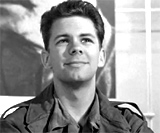 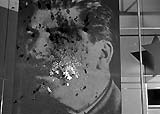 Raymond Shaw's Shooting of Bobby Lembeck, With Blood Splatter on Poster of Stalin 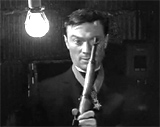 Shaw Blowing His Own Brains Out |
||||||

|
In Hitchcock's horror film about unexplained lethal attacks from birds, Mitch's (Rod Taylor) mother Lydia Brenner (Jessica Tandy) drove off in a Ford pickup truck toward neighbor Dan Fawcett's farm, to discuss their problems with chickens. She drove up to the farm where hired farm hand George (Bill Quinn) welcomed her in the yard and encouraged her to find Dan Fawcett inside. After Lydia entered alone into the unlocked kitchen door where there was no answer, she called out: "Dan, are you home?" Again, a row of neatly-broken teacups dangling from hooks under the kitchen cabinet caught her shocked attention. As she walked down the empty, deathly silent, narrow and tunneling corridor to a bedroom, she discovered a dead seagull impaled in a broken window and an upturned, bric-a-brac plastic bird sculpture. From another angle, there were more signs of chaotic damage in the room - bird feathers, two more dead birds, and a disordered bed. On the floor were two bloodied, bare feet sticking out from a pair of shredded pajama pants. In three jump shots that zoomed forward to his face, Lydia witnessed Dan Fawcett's lifeless body propped in the corner of the room. Both of his bloody, darkened eye sockets were empty - plucked out during the bird attack. Her reaction to the mutilation of his eyes - coupled with the film's theme of seeing - was beautifully realized. She turned and fled down the hallway with her hands in the air and her mouth gaping open. Wide-eyed and gasping for air, she was unable to verbalize the unspeakable horror to the bewildered farm hand. Her truck backfired - 'screaming' in its own way - and its path churned up dust as she roared back at top speed to the Brenner home. |
 Dead Seagull in Window    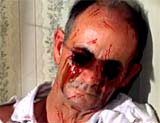 Three Jump Shot Zooms Toward Plucked Face of Dan Fawcett |
||||||
(chronological by film title) Intro | 1915-1929 | 1930-1933 | 1934-1938 | 1939 | 1940-1942 | 1943-1945 | 1946-1947 | 1948-1949 1950-1952 | 1953-1955 | 1956-1957 | 1958-1959 1960-1961 | 1962-1963 | 1964-1966 | 1967-1968 | 1969-1970 1971 | 1972 | 1973 | 1974 | 1975 | 1976 | 1977-1978 | 1979 1980 | 1981 | 1982 | 1983 | 1984 | 1985 | 1986 | 1987 | 1987 | 1988 | 1989 1990 | 1991 | 1992 | 1993 | 1994 | 1994 | 1995 | 1995 | 1996 | 1997 | 1998 | 1998 | 1999 2000-2001 | 2002 | 2003 | 2004 | 2005 | 2006 | 2007 | 2008 | 2009 | 2010 | 2011 |